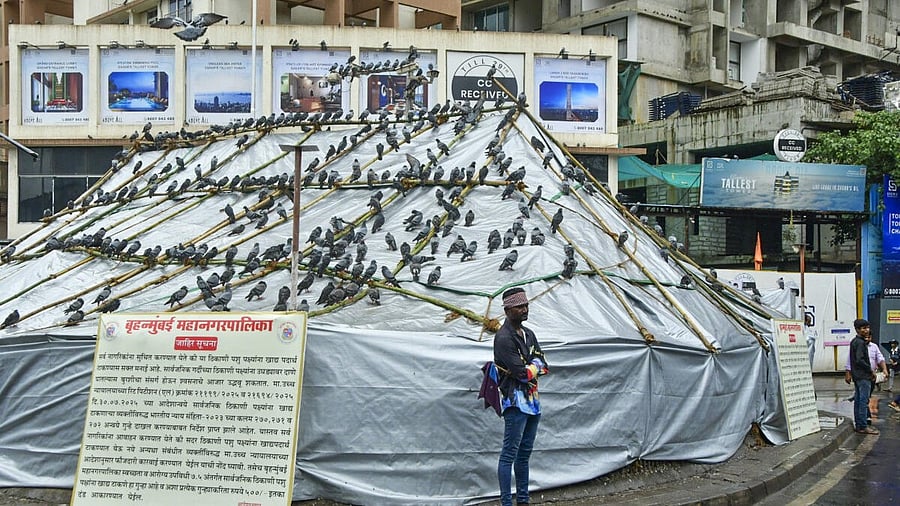
A man stands next to a 'kabutarkhana' (pigeon feeding area), covered in sheets by BMC, at Dadar, in Mumbai.
Credit: PTI Photo
Mumbai: There is an urgent need to address the overpopulation of pigeons in Indian cities, not only to protect biodiversity but also to safeguard human and animal health, said Kishor Rithe, the Director of Mumbai-headquartered Bombay Natural History Society (BNHS).
“With support from citizens, government authorities, and conservation organizations like BNHS, community-based solutions can be implemented. Sustainable conservation requires informed action – rooted in science and empathy, not blind rituals. Let us help birds the right way – by nurturing their natural habitats and supporting ecological balance,” said Rithe.
The BNHS chief’s statement assumes significance in the wake of the BrihanMumbai Municipal Corporation’s decision to cover the kabutarkhana in Dadar and the protests.
In fact during the monsoon session of the Maharashtra legislature, the issue has figured during which the government admitted to 51 kabutarkhanas in Mumbai.
Speaking about the pigeons, Rithe, an environmentalist, naturalist and conservationist said: “The Common Pigeon (Columba livia), also known as the Blue Rock Pigeon or Kabutar, typically inhabits cliffs and rocky outcrops, which it prefers for nesting. However, in urban environments, these natural nesting sites have been replaced by parapets, air conditioning units, and other flat surfaces on buildings. Due to the continuous availability of food, urban pigeons now nest year-round, unlike their counterparts in the wild, whose breeding coincides with seasonal food availability. In natural ecosystems, predatory birds help control pigeon populations, but urbanization has drastically reduced the number of such predators in cities.”
In a detailed analysis - ‘Pigeon menace in Urban India’, in BNHS magazine Hornbill, Rithe said one major reason for pigeons’ preference for urban areas is ‘compassionate feeding’ by humans.
According to BirdLife International and the IUCN, the global population of common pigeons is approximately 2.6 billion. In India, the State of India’s Birds report found that the common pigeon is the most abundant urban bird, followed by the House Crow.
This surge in pigeon populations has significant consequences, including changes in native bird species composition, decreased avian biodiversity, and impacts on human health.
In many Indian cities such as Delhi, Lucknow, and Indore, designated pigeon-feeding areas – known as kabutarkhanas are maintained by registered or unregistered trusts. People often gather at these feeding stations to offer grains, motivated by religious beliefs that feeding pigeons earns spiritual merit (punya) or brings prosperity. Many also assume that the pigeons are dependent on human feeding for survival. Additionally, private feeding stations have emerged on balconies, terraces, and windowsills, further exacerbating the problem.
This artificial feeding has led to an unchecked increase in pigeon numbers, particularly in the absence of natural predators. Cities like Mumbai have witnessed pigeon populations surpassing the ecological carrying capacity. Even if this compassionate feeding stops, pigeons will still survive – but in smaller, more sustainable numbers based on natural food sources. Reliance on human feeding has diminished their ability to forage, an essential survival behaviour in wild birds. Moreover, improper feeding practices can lead to nutritional deficiencies in pigeons and attract other urban pests like rats and mice.
“Veterinarians have warned that pigeon feeding stations may become hotspots for disease transmission. Dried droppings turn into airborne particulates (fomites), facilitating the spread of infections. Symptoms such as coughing, rhinitis, joint pain, and headaches are common in areas with high pigeon activity. Residents exposed to pigeon droppings are at significant risk,” said Rithe.
"Doctors believe that the public is at significant risk of contracting diseases, as pigeon droppings are found almost everywhere – on roads, in the soil, and especially in the nests pigeons build in our homes. A single pigeon can produce 12–15 kilograms of droppings annually, and since the faecal matter can become airborne, it can easily enter our lungs. In urban areas, this risk is exacerbated by poor air quality,” he said.